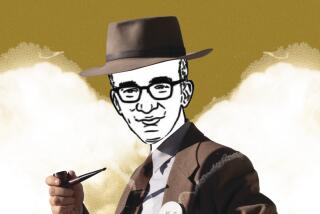Review: Elin O’Hara Slavick invokes ghosts of Hiroshima
Elin O’Hara Slavick photographs survivors of the atomic bombing of Hiroshima. Not human survivors but objects that factor into everyday life — bottles, brooms, combs — and emblematize their users. Technically, the pictures are photograms, direct traces of the physical objects themselves. What Slavick produces are ghosts, haunting images from a past that, to paraphrase Faulkner, is neither dead nor past.
A professor at the University of North Carolina at Chapel Hill, Slavick is engaged in what she terms “ethical seeing.” She examines the aftermath of war, its visible residue, as an act of remembrance, a kind of post-witnessing laced with pathos and latent protest.
CHEAT SHEET: Fall arts preview
She makes crayon rubbings of blast-affected surfaces (keyholes, a wooden floor, a shard-pierced wall) that she then photographs, creating mysterious prints of pure, violence-induced texture — grainy, pebbly, blistered, molten. Most of the works in her stirring show at Cohen, however, are made by placing objects from the Hiroshima Peace Memorial Museum directly onto cyanotype paper and exposing them to the sun. The process yields a negative silhouette, a variably opaque white shape floating in a field of blue. Portraits of individual bottles damaged by the blast are the most affecting; humble and disfigured, they assume anthropomorphic presence and stand in poignantly for human victims.
On the day of the bombing, the radiation blast produced negative shadow images of incinerated objects as well as people, framing their absence. Those horrific, incidental prints are echoed afresh in Slavick’s vivid, mournful work.
Cohen Gallery, 7354 Beverly Blvd., (323) 937-5525, through Nov. 2. Closed Sunday and Monday. www.stephencohengallery.com.
More to Read
The biggest entertainment stories
Get our big stories about Hollywood, film, television, music, arts, culture and more right in your inbox as soon as they publish.
You may occasionally receive promotional content from the Los Angeles Times.






